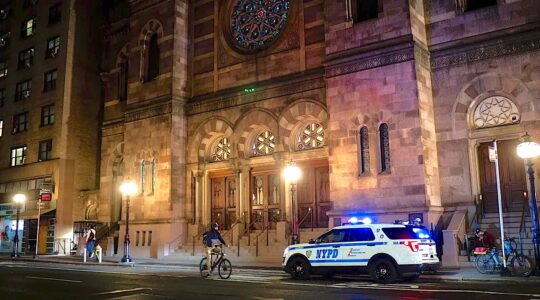While there’s frequent news these days of bookstores closing and publishers downsizing, the really good news is that two new publishers interested in Jewish literature are introducing their first titles this season. Fig Tree Books is a new independent press publishing literary fiction about the American Jewish experience, issuing new works by Jonathan Papernick and Jessamyn Hope, a classic novel by Meyer Levin and others. And Mandel Vilar Press, who begins its list with new novels by Thane Rosenbaum and Alan Lelchuk, is dedicated to books representing “inclusive diversity” in the literature of the Americas. May they flourish.
Fiction
In “Angels at the Gate,” (Cappuccino Books), T.K. Thorne imagines the life of the biblical figure of Lot’s wife, who turns into a pillar of salt in Genesis. Unnamed in the text, she is the independent and determined Adira in this story of ancient times. Thorne, the author of another work of historical fiction, “Noah’s Wife,” recently retired after serving as the first Jewish female officer in the Birmingham (Ala.) Police Department. (March)
The Weimar Republic is the setting for Alexis Landau’s debut work, “The Empire of the Senses” (Pantheon), a family drama and historical novel. She captures the culture and milieu of the times, as she explores issues of culture, assimilation, love and loyalty. (March)
While Martha Mendelsohn’s debut work “Bromley Girls” (Texas Tech) is published as a young adult novel, readers of all ages will be drawn to her New York story, set at a prestigious girls’ school, with themes of identity, family and, friendship, with shadows of prejudice in the background. Mendelsohn has a great ear for the way young women speak and maneuver through the cliques and dramas of coming of age. (March)
Set in Miami Beach in 1972, “How Sweet It Is” by Thane Rosenbaum (Mandel Vilar Press) is a portrait of the sun-drenched city in an era very different from today. His thoughtful and very funny tale involves gangsters and Holocaust survivors along with Isaac Bashevis Singer, Jackie Gleason, Meyer Lansky and someone who may be Fidel Castro. The author, who grew up in Miami Beach, has an uncanny feel for the haunts of the city and its soul. (April)
Alan Lelchuk’s “Searching for Wallenberg” (Mandel Vilar Press) is a literary detective story and love story about a professor/novelist who sets out for Eastern Europe to try his hand at investigating the disappearance of Swedish diplomat Raoul Wallenberg, who saved the lives of thousands of Jews in Budapest. Along the way, the professor meets a Hungarian woman claiming to be Wallenberg’s daughter. (April)
“The Book of Aron” (Knopf) is a novel of the Holocaust from a surprising source, Jim Shepard, author of seven novels and four collections of stories. The unforgettable story unfolds from the point of view of an appealing and quirky child whose family is forced to leave the Polish countryside for the Warsaw ghetto. After the boy loses his parents, he is rescued by Dr. Janusz Korczak, and joins his orphanage. (May)
From Jonathan Papernick, “The Book of Stone” (Fig Tree Books) is a compelling psychological thriller, with gangsters, crime and religious terrorism; it’s about fathers and sons, Arabs and Jews, and is set in post-9/11 Brooklyn. (May)
In Jessamyn Hope’s debut novel, “Safekeeping” (Fig Tree Books), six unlikely characters meet at Kibbutz Sadot Hadar (“Fields of Splendor”). One of them, a troubled young man from New York City, arrives on the kibbutz to volunteer, with hopes of finding the woman his grandfather loved there 50 years earlier — and to present her with a family heirloom sapphire brooch. The book has much to say about love, loss and what’s worth keeping. (June)
Poetry
“Made in Detroit” by Marge Piercy (Knopf) is a collection of new poems that address her early life in Detroit, her present home on Cape Cod, and her views of Shabbat and Jewish holidays, especially Yom Kippur, marriage, nature and friends no longer in this life. (April)
Support the New York Jewish Week
Our nonprofit newsroom depends on readers like you. Make a donation now to support independent Jewish journalism in New York.
Non-Fiction
Aviva Gottlieb Zornberg continues her explorations of biblical texts in her distinctive and impressive narrative style. “Bewilderments: Reflections on the Book of Numbers” (Schocken) is layered with literary, psychological, mystical and classic sources. (February)
“Open Up the Iron Door: Memoirs of a Soviet Jewry Activist” by Rabbi Avi Weiss (Toby Press) is both a personal memoir and the story of the grassroots Soviet Jewry freedom movement in which he was a key player. From 1964 to 1991, he and other Western Jewish activists worked tirelessly, against impossible odds, and that experience was a cornerstone of Rabbi Weiss’s life of “spiritual activism.” The book is dedicated to Glenn Richter, “Tzaddik of the Soviet Jewry Movement.” (February)
“The Year My Mother Came Back” (Algonquin) is Alice Eve Cohen’s memoir and love story about parenthood, loss and connection. With honesty and humor, Cohen describes a particularly challenging period of her life, when her late mother seems to reappear to help her find her way. (March)
Shulem Dean’s “All Who Go Do Not Return” (Gray Wolf) is a powerful addition to the growing bookshelf of memoirs by people who grow up in the chassidic world, leave everything they know behind, and try to find a place for themselves in what had previously been considered the forbidden outside world. Many of the recent titles have been written by women, and Dean’s is the rare male voice – he speaks of the heartbreak of being separated from his five children. The former Skverer chassid, founder of the website Unpious, writes with candor and sensitivity as he describes New Square — from which he is expelled for heresy — and its way of life and his own struggles. (March)
Hannah Nordhaus goes back more than a century to uncover and understand the story of her great-great-great grandmother, who came to America from Germany as a pioneering young bride in 1866. According to local legend in Santa Fe, where she settled, her ghost has long remained. “American Ghost: The True Story of a Family’s Haunted Past” (Harper) is a well-researched memoir that’s full of compassion and good questions that linger. (March)
“Ravensbruck: Life and Death in Hitler’s Concentration Camp for Women” by Sarah Helm (Nan A. Talese) is a groundbreaking in-depth work, describing the Nazis’ crimes against women. Helm was able to do research in newly opened archives and to interview survivors. Ninety percent of the prisoners at Ravensbruck were not Jewish, but they included political prisoners, resistance fighters, the sister of New York’s Mayor Fiorello LaGuardia, Polish countesses and a former British golf champion. The courage of these women is remarkable. (March)
In “Jewish Wisdom for Growing Older: Finding Your Grit and Grace Beyond Midlife,” Rabbi Dayle Friedman (Jewish Lights), a leading teacher, scholar and spiritual guide who has done much creative work in the field of aging, offers practical and spiritual advice. (March)
“Lincoln and the Jews: A History” by Jonathan D. Sarna and Benjamin Shapell (Macmillan) presents rare manuscripts, letters in Lincoln’s hand, artifacts and images that tell the historical story of Lincoln’s relationship with Jewish people. (March)
For “Just Kids from the Bronx: Telling It the Way It Was — An Oral History” (Henry Holt) Arlene Alda interviewed more than 60 Bronx natives, including many Jewish sons and daughters of the only borough with an article before its name, including Carl Reiner, Daniel Libeskind, Jules Feiffer, Robert Klein, and Maira Kalman; there’s also a posthumous piece from A.M. Rosenthal, longtime managing editor of The New York Times. Alda presents their voices, recounting childhood apartments, street games, front stoops, and the opportunities and freedom they experienced and now relish. (March)
“The Life of Saul Bellow: To Fame and Fortune 1915 – 1964) by Zachary Leader (Knopf) is a biography of the most decorated writer in American history, drawing connections between his life and his writing. Leader, an American professor in London who has previously written a biography of Kingsley Amis, was granted unprecedented access to the writer’s papers. The first of a planned two-volume set, the book is more than 800 pages. (April)
The New York Jewish Week brings you the stories behind the headlines, keeping you connected to Jewish life in New York. Help sustain the reporting you trust by donating today.




